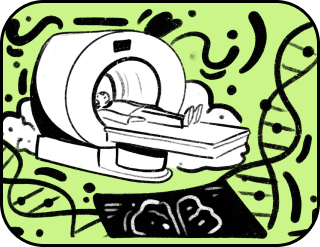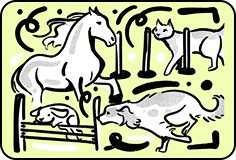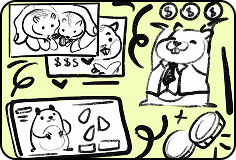Category: Life technologies
How to Measure Fear
“Fear is not in danger itself, but within us”
Stendhal
Highly sensitive viewers, be warned. We’re about to show you a morning of horrors—terrifying even to watch from the sidelines.
Scene 1. The alarm clock rings—one hour late. Citizen X, drenched in cold sweat, leaps out of bed. A nightmare! The office meeting has started without him.
Scene 2. In the apartment across the street, Citizen Y has been up for hours. Everything is going according to plan—until IT appears. A dreadful spider with its hairy legs. Horror! In panic, the apartment owner lets out a shriek and lunges toward the camera.
The question that should stir the curious reader’s mind sounds something like this: “Whose horror is more horrible?”
Our editorial team, with a known weakness for exact sciences, proposes to measure fear—both in everyday life and from a strictly scientific perspective.
The phrase “I’m SO scared” sounds quite mysterious when taken out of context. To paraphrase Oscar Wilde, fear is in the eyes of the beholder. Triggers can be strange, to say the least. Pogonophobia (the fear of beards and their wearers) is a case in point. Hence, the degree of fear is deeply personal.
We introduce the System of Everyday Coordinates (SEC)—a toolkit for visualizing and neutralizing fear. Forget the lab instruments; a personal nightmare can be measured by simpler means:
1. THE PARANOIA SCALE—Units of Tension (UT)
What it measures: The level of background, diffuse fear that paints reality in anxious tones.
Reference: 1 UT = one involuntary flinch at the sound of a creaking door in an empty apartment.
Scale:
10–20 UT (Mild anxiety): You double-check that the door is locked before leaving home.
Action: “Conscious completion ritual.” Instead of giving in to habit, slow down. Lock the door mindfully, say to yourself “The door is closed,” take one step back, and mentally place a period. This tells the brain the task is complete, breaking the anxiety loop.
30–50 UT (Moderate paranoia): You plan routes to avoid dark alleys.
Action: “Narrative shift—from defensive to exploratory.” Replace “something bad could happen” with “What interesting things might I notice here?” and “How beautiful the details on the facades are!” Curiosity expands perception; anxiety narrows it.
75–100 UT (Critical level): You hear footsteps behind you in an empty street; your heart races.
Action: “Grounding technique 5-4-3-2-1.” Panic disconnects you from reality. Return to it through your senses. Name to yourself:
▪️ 5 things you see (asphalt, streetlamp, your own shoes, graffiti, moon).
▪️ 4 things you can touch (sewing seam on a jacket, cold key in the pocket, wind in the face).
▪️ 3 sounds you can hear (your own step, distant hum of cars, that very suspicious step that has now become just one of the sounds).
▪️ 2 smells (humid air, smell of the city).
▪️ 1 taste (The taste of your own fear? The taste of your previous coffee?).
This returns the mind to the present, diverting energy from fear to awareness.
Philosophy: We don’t fight fear head-on—we change the rules. We turn rituals into mindfulness, catastrophes into curiosity, and panic into presence.
2. THE IRRATIONAL INVESTMENT SCALE: Panic Expense Coefficient (PEC)
What it measures: Willingness to spend real resources (time, money, energy) combating an unlikely threat.
Reference: 1 PEC = one extra spray of insect repellent in a forest where you haven’t seen a single tick.
Scale:
10–20 PEC (Basic precaution): You buy gadget insurance.
Action: “Risk-exchange rule.” Compare the 500 rubles you spend on pointless insurance with 500 rubles for a coffee and dessert. Transform abstract “safety” into a tangible choice.
30–50 PEC (Active warding ritual): You empty half a can of bug spray on yourself.
Action: “Ritual of closure and trust.” Do exactly five sprays, snap the cap shut, and put the can away. The sound signals completion—a cue for your brain to relax.
75–100 PEC (Desperation ritual): You cancel the forest trip due to tick warnings.
Action: “Probability analysis.” Compare risks—tick bite vs. car accident en route. Make a clear “worst-case” plan or an algorithm of actions. Fear feeds on uncertainty; a plan dissolves it.
Philosophy: We don’t deny fear; we redefine our relationship with it—from control to conscious choice.
3. THE INFORMATION HUNGER SCALE: Digital Dependence Index (DDI)
What it measures: The panic about ending up in an informational vacuum or being cut off from social approval.
Reference: 1 DDI = one pointless messenger check when there are no new messages.
Scale:
10–20 DDI (Mild itch): You constantly check your phone.
Action: “Mindful pause.”
Ask yourself: “What need am I trying to meet? To fill the information gap? Or perhaps to have a rest?” Observe without judging. Give yourself 30 seconds to simply be.
30–50 DDI (Compulsive habit): You refresh your feed every 5 minutes.
Action: Physical anchor of presence.” Place your phone face-down, put keys or a napkin on top, and zip it in your bag. The small barrier breaks the automatic reflex and gives you a second to become conscious of your actions.
75–100 DDI (Digital withdrawal): Without your phone, you feel physical discomfort.
Action: “Experiment of meeting yourself.” Spend 30 minutes alone, listening not to silence but to the real world—traffic, breathing, a clock ticking. You’ll find solitude can be company.
Philosophy: We don’t suppress addiction; we observe our impulsive behaviour, create mindful barriers, and rediscover reality beyond screens.
4. THE SOCIAL ANXIETY SCALE: Shyness Coefficient (SC)
What it measures: Fear of judgment, rejection, or ridicule.
Reference: 1 SC = one withheld opinion in a small group out of fear of sounding foolish.
Scale:
10–20 SC (Mild unease): You worry before public speaking.
Action: “Shift from self to mission.” You’re not the show—you’re the conduit. The audience came for information, not judgment.
30–50 SC (Noticeable discomfort): You decline a party invitation full of strangers.
Action: “Social observer tactic.” Notice three subtle details in the room, then start one micro-conversation based on an observation. Curiosity replaces self-consciousness.
75–100 SC (Paralyzing dread): The thought of calling a stranger makes you panic.
Action: “Grounding in contact.” Feel your feet on the floor, clench your fist three times, and imagine the person on the line as friendly and distracted. You’re not being judged, your voice timbre isn’t analysed; you’re just calling.
Philosophy: We don’t force bravery. We shift roles—from defendant to guide, from actor to observer, from victim to researcher.
5. THE EXISTENTIAL DESPAIR SCALE: Level of Metaphysical Dread (LMD)
What it measures: The vague yet overwhelming fear of meaninglessness, the future, or cosmic loneliness.
Reference: 1 LMD = one sudden midnight thought about the infinity of the universe that takes your breath away.
Scale:
10–20 LMD (Momentary melancholy): You feel sad on a rainy evening.
Action: “Tactile grounding.” Wash dishes, focusing on the warmth, texture, and weight of each cup. Sensation brings you back from the cosmic void.
30–50 LMD (Lingering gloom): You feel sad for several days.
Action: “Externalizing the inner state.” Draw your feeling—as a color, line, shape or texture. Transform the infinite into something finite and visible.
75–100 LMD (Existential crisis): You’re paralyzed by the thought “What’s the point of it all?”
Action: Shift of focus.” Ask: “Whose purpose can I serve right now?” You can’t find Meaning—you can become it, through connection.
Philosophy: We don’t cure existential dread as it comes from erroneous thinking; we translate it. From fog to map, from abstract to concrete, from emptiness to small, real bridges back to life.
THE GLOBAL TECHNOLOGY editorial does not guarantee the accuracy of the results obtained in the laboratory of everyday decisions. Science is aware of over 500 types of phobias, including phobophobia—the fear of being afraid. In each specific case, the manifestation of pathological fear, to an untrained scientific eye, appears as something extraordinary. I would like to reach a common denominator in this irrational coordinate system, so to speak, to measure it with a “single yardstick.”

The method and unit of measurement depend on who holds the horror-meter.
Psychologist. Measures fear in monsters a patient can see in inkblots—the legacy of Swiss psychiatrist Hermann Rorschach. In this test, people project inner fears onto ambiguous images.
Psychologists can also use traditional scores as units of measurement. This approach is proposed in the “Types of Fear” questionnaire, developed by Irina Shkuratova. The test subject is asked to rate their fear on a four-point scale (from “I have never experienced this” to “It constantly pursues me”) when exposed to one of thirty-six factors. This results in a kind of “self-judging” process. Interpretation, of course, depends on the observer—proving again that fear is in the eyes of the beholder.
Clinician. Takes a more physiological approach, measuring fear in 4D: heart rate, hair height, pupil dilation, skin tone, and even weight changes. Units may include:
- heartbeats (60–90 bpm and above): the heart doesn’t just “sink”—it runs for its life;
- millimeters: hair literally stands on end; pupils diameter dilate. “Fear makes the eyes wide” is biologically accurate;
- skin tone: pallor or bluish tint from vascular spasms;
- grams: fear burns calories. In 2012, researchers at the University of Westminster found horror-movie fans lose weight due to adrenaline-induced metabolism spikes. According to data published in the Daily Telegraph, it has been found that a frightened person loses weight because the increased heart rate and accelerated metabolism reduce appetite.
Having taken our measurements, we can answer the next logical question: “Why measure fear at all?”
Because prolonged fear is dangerous. Like blood sugar, adrenaline levels need monitoring. It’s natural to feel fear; it’s unnatural to live inside it. While you waste energy spraying repellent, someone else is already collecting your mushrooms.
And that’s just the beginning: heart attack, stroke, depression—an endless list of horrors for those who choose to live life in the horror genre.
We wish you, in every frightening situation, to get away with nothing worse than a mild scare!

The cell divides into the nucleus and cytoplasm. Our journal divides into interesting facts and discoveries.
Thank you!




